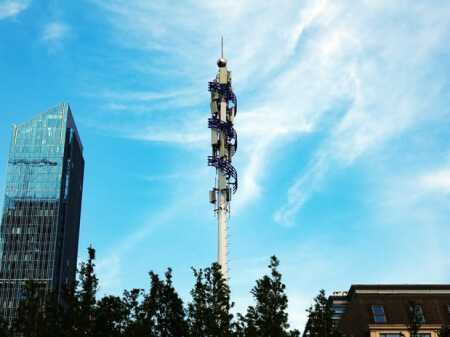Commercial structures could be a formidable barrier to 5G wireless.
One aspect of 5G wireless will be anything but fast—bringing the benefits of this next-generation mobile broadband into large structures.
In-building reception has been an issue with earlier wireless technologies. But 5G’s fastest, most responsive frequencies can have trouble getting through foliage, much less reinforced concrete.
“5G will have a very challenging time propagating the signal through building materials,” says Arie Barendrecht, chief executive officer of WiredScore, a New York City firm that rates the connectivity of commercial structures. “This is already a challenge with 4G. We hear lots of tenants complaining about cell signal in buildings even today.”
The treatment for that condition should remain the same as the technology moves from 4G to 5G—a distributed antenna system (DAS) that brings the outside signal deep into workspace interiors. Barendrecht cites prices of $1 to $3 per square foot [11 to $32 per sq m], but these are becoming a table-stakes item in negotiations between landlords and tenants.
Commercial structures can pose two particular problems for wireless reception: heights that take them far above cell antennas pointed toward the ground, and window coatings on buildings constructed or renovated for energy efficiency. “Low-E glass is the equivalent of two feet [0.6 m] of concrete being wrapped around the building,” Barendrecht says.
The millimeter-wave version of 5G employs much higher frequencies than today’s cell service to deliver speed and responsiveness competitive with fiber-optic broadband—download speeds above 1 billion bits per second and latency times below 10 milliseconds—but over much shorter distances.
For the Boston firm Starry, which provides fixed-wireless residential broadband over millimeter-wave frequencies similar to those of 5G, the answer is to focus on extending millimeter wave’s outdoor range and not try to make indoor reception happen at all.
“We have done extensive testing in these bands,” says Virginia Lam Abrams, Starry senior vice president for communications and government relations. “Milli-meter waves do not permeate modern construction materials like concrete and foil-backed insulation, and attenuate very easily.” Instead, the company has technicians install a Starry Point receiver outside a building and connect it to a router in each residence via existing wiring.
Wireless carriers are also deploying 5G over mid- and low-band frequencies that travel farther than millimeter wave but do not match its speed and low latency.
Qualcomm, which has developed much of the current 5G technology, says it has been able to provide 90 percent millimeter-wave 5G coverage in office spaces by putting 5G small cells adjacent to existing 4G repeaters.
But building owners that installed a DAS may find themselves punished for their early adoption of gear that is not upgradable to 5G. “We recently met with a [chief information officer] of one of the largest REITs [real estate investment trusts] in the United States,” Barendrecht says. “They need to rip and replace 80 percent of their DAS systems.”
Structures with more interior framing or more densely packed offices may require additional work. “5G DASs are going to need to be super dense in office spaces due to the attenuation of concrete, and it’s going to be a huge retrofit action for most of the buildings,” warns Tom Bridge, a partner at Technolutionary, a Washington, D.C., information technology consulting firm.
Barendrecht advises architects to allow room in basements, walls, and ceilings for the cables required to weave together a DAS. “We always say 95 percent of wireless is wired,” he said.
But he also suggests that building operators would be wise to wait as long as possible to pick a 5G-ready DAS. “We’re seeing kind of every six months now an iteration of what a new best-in-class system looks like,” he says.
ROB PEGORARO is a freelance writer who lives just outside Washington, D.C., and covers tech issues for such outlets as Yahoo Finance, USA Today, and Wirecutter.





